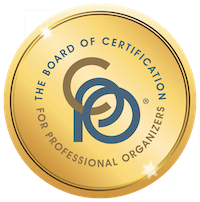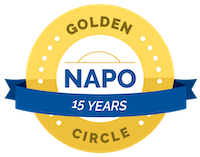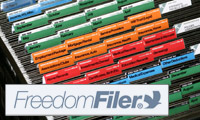Getting my desk under control
Last week, my desk got out of control. I had a leather in tray that was overflowing, despite my having gone through it recently. I had a busy client week and spent what time I was at my desk dealing with urgent items. Look how bad it got. (I’m not proud of this picture.)

So yesterday I decided I needed to get serious about my desk. It took me a couple of hours, but here’s how it looked this morning:

It’s so much easier to think about getting work done when I have a clear desk!
Here’s how I went about doing it:
- I cleared all paper, even the stuff I was storing in my desktop riser, off the desk into a container.
- I (permanently) removed the leather paper tray.
- I made sure a trash can and recycling bin were nearby.
- I started going through the items in the container, tossing many papers and filing others in clear project view folders.
- I organized a couple of current move projects on a clipboard for easy use on site.
- I scanned a few papers and tossed them.
- I used a medium Multipurpose Bin from The Container Store (which I had on hand) to contain the project files and project clipboards.
To keep my desk more clear, I placed the multipurpose bin on top of the radiator behind my desk. That way the files are handy, but not in my way. When I have a little more time, I think I’ll clean out the rolling file cart under my desk to make room for those project files.
Here’s a picture of that action bin. It makes the radiator more crowded than I’d like (next to it are notebooks I like to keep close at hand), but I think it’s going to work.

It’s so easy for me (and my clients) to let stuff clutter up a desk unnoticed until it’s out of hand. It feels really great to have taken a little time to focus on my desk. My intention this week is to put everything away before closing up shop for the evening (which was part of a wonderful evening routine I had back in the day). I think it’s going to make for a highly productive week!
Ten things I know are true
I started Peace of Mind Organizing® in July 2005. When I made this big transition from being a writer, I strongly suspected it would bring me happiness. (You can read about why I became a professional organizer, if you’re interested.) What I didn’t know then is how much I would learn and what a life changing profession it is. On my tenth anniversary, I reflected on ten truths I’ve learned as an organizer. I want to share them again today on the occasion of my 13th anniversary.
Thinking about my anniversary, I took a moment to write down ten things I’ve learned as a PO that have been proven true over and over again. I thought I’d share them with you this month.
- The less stuff you own, the easier your life is. Less stuff = more freedom.
- Relationships are more important than things. Don’t let your stuff get in the way of your relationships.
- There is no such thing as perfectly organized. Strive for “organized enough” instead.
- You can’t put something away unless you have a place for it. And you can’t have a place for it if you have more stuff than you can comfortably store.
- It’s easiest to create a new habit if you pair it with something you’re already doing. Use that trick to let habit creation be easy.
- Indecision leads to clutter. Make it a habit to decide immediately what to do with items.
- It’s okay to ask for organizing help. In fact, it can be very beneficial.
- Messy does not equal disorganized. I’m living proof.
- Tidy does not equal organized. I’ve seen many neat but disorganized spaces.
- You are not your stuff. Don’t let your stuff (and your ability to organize it) define you.
Worth repeating: Have that difficult conversation
Three years ago, shortly after my mother passed away on June 17, 2015, I wrote a post about helpful it was that we had talked about what kind of arrangements she and my father would like after their deaths. The workbook we’d filled out was invaluable and since then my father and I have gone through it again to make sure it’s up to date. The issue is so important, I thought I’d share the post again today.

My mother, Betty Sue Brown Adams, passed away on June 17, 2015. She’d been living with Parkinson’s Disease for years and the end of her life was swift and peaceful. My father, brothers, and I took great comfort in that.
One other source of comfort was the pre-planning we did back in 2006, when my mother was 73 and relatively healthy. I had just taken a two-day estate organizing workshop from Jeanne Smith of Exit Stage Right. One day was on helping people organize their affairs prior to death. The other day was on helping people organize after the death of a loved one.
That workshop was in California and I headed straight up to Walla Walla, Washington, to visit my parents. I asked them to help me in my training by going through the pre-death organizing process. The conversations were actually pretty easy and, believe it or not, we had a little fun going through the Exit Strategies workbook that Jeanne created and sells.
Nine years later, that planning paid great dividends after my mother passed away. That very night, we pulled out the workbook and pored over the pages in which my mother had specified her desires for the details of her memorial service (down to the flowers and music), burial, and obituary.
Those pages were absolutely invaluable the day after my mother’s passing, when my father and I went to the funeral home. We did not have to speculate what my mother would have wanted. And thanks to the workbook, the obituary practically wrote itself.
The workbook also provides a handy checklist of things to do after a death, as well as people to inform.
My father and I have agreed to go through the workbook again and make sure his desires and other information (like his financial account information) are up to date.
I urge you to consider discussing these details with your loved ones. Jeanne’s workbook is a terrific tool, but any information you gather will be helpful. It can be a difficult discussion to have, but it’s much easier to have it while folks are healthy. Since my mom died, my dad has expressed over and over how grateful he is that we did it. (I overheard him on the phone brag to someone that they worked with a professional organizer to do this planning.)
The pre-planning we did made a difficult time much easier. It’s yet another way being organized can be beneficial.
True independence
Here in the United States, it’s Independence Day. That got me thinking about what independence means to me.
A few years ago I created a little graphic to declare what I think brings true freedom.

I’ve been helping people gain that independence for thirteen years. The longer I do this work, the more sure I am that we’re all better off when we surround ourselves with less.
Photo by Paul Poli via Flickr.
Is the iPhone X worth the high price?
I bought my first iPhone in 2012 (it was a 4S) and have upgraded every two years. Three weeks ago, I took the plunge and upgraded from my iPhone 6s to the iPhone X. I hesitated for three reasons: (1) the 6s was working quite well; (2) the X has a learning curve since the home button was removed; and (3) it costs $1149 for the 256 GB phone, which I wanted.
So is the iPhone X worth all that money? My answer is a resounding yes!
I selected the Apple Upgrade plan, which means that I’m paying some $55 a month over two years, after which the phone is mine. Or I can turn the phone in any time after one year and upgrade to a new phone without having to pay the balance. The monthly payment includes Apple Care.
Here’s a picture of my phone’s lock screen:

That's my standard poodle, Bix, on the right with his BFF, Finn.
The main reason I was drawn to the iPhone X is that its screen covers the entire front of the phone, which means that I get a much larger screen without a significantly larger phone. That’s great for me because my aging eyes were having trouble reading the iPhone 6s. I went from a phone that is 5.44” tall x 2.64” wide with a 4.7” display to a phone that is 5.65” × 2.79” (just a little bit larger) with a 5.8” display. That extra 1.2 inches makes a big difference.
I’m happy to report that I did not experience a learning curve. Swiping up, rather than pressing the home button, has come very naturally to me. In fact, I find the iPhone X easier and more enjoyable to use than my others, all of which I loved.
And I’m also enamored of the Face ID. Rather than using my fingerprint or entering a code to open my phone, I just look at it. I’m amazed how well that works. And it works every time (unlike my fingerprint on my 6s). I haven’t had any problems with Face ID when I use Apple Pay, though I’d been warned that I might.
I’m not a big photographer, but I use my phone’s camera a whole lot. (Pictures of Bix are liberally sprinkled throughout my photo stream.) The iPhone X’s camera is amazing. I haven’t even yet availed myself of all the features and I can still appreciate how good it is.
Since I have Apple AirPods (which I also love), I haven’t missed the absence of the ear phone jack. I was happy the new phone came with an adaptor so I can use my Square card reader, which attaches to the phone jack.
I immediately purchased a new Loopy case when I bought the phone, so I’m not worried about dropping my expensive new device.
And, finally, my iPhone X is much faster than my iPhone 6s was. I’m one happy camper. I’m fortunate to be able to afford the $55 a month charge and I feel the phone is worth it.
Stop the Clutter! cards
I’m always trying to figure out ways to make organizing/decluttering/task management fun. You may remember To-Do List Bingo for example.
So I was intrigued when I learned that a colleague in Columbus, Ohio, Karen Kruzan of K-Squared Organizing, had created a deck of cards to help people declutter and organize. They’re called Stop the Clutter! cards. So of course, I bought a deck to try them out.
I took this picture:

A representative decluttering card
The deck of 56 tarot-sized action cards is split into four categories:
- 14 blue decluttering cards
- 12 red organizing activity cards
- 16 green self-awareness activity cards
- 10 yellow self-care cards
Each card has an activity of some sort on it. The idea is that you shuffle the deck and then each day (or perhaps less often if you’re really busy) you draw a card and complete the activity. The cards offer advice along with the activities.
I think this is just brilliant! For someone who needs help figuring out where to get started, it could be so helpful. Not knowing what you’re going to be working on makes it fun. I think it’s great that the activities are quick but together they add up to a huge amount of progress. And, of course, I absolutely love that self-care activities are part of the deck.
Karen, who is also psychotherapist as well as an organizer, has clearly put a whole lot of thought into the activities in the deck. I heartily encourage you to check them out!
New podcast! Getting to Good Enough

I am ridiculously excited to announce the launch of the new podcast Getting to Good Enough, hosted by me and pal and life coach Shannon Wilkinson.
It feels really good to be collaborating with Shannon again. We have co-presented in-person workshops on more than one occasion. Wepartnered on Declutter Happy Hour, back in the day, along with Quick Clutter Fix and Why Resolutions Don’t Work (and How to Get What You Want Anyway). All those projects were fun, but they’re not for sale anymore.
This podcast was Shannon’s idea and I jumped at the chance to work with her again. It is designed to help you overcome perfectionism so you can live the life you want to lead. We come at it from different perspectives: I’m lucky enough naturally good at good enough. As you know if you’ve been reading my blog for awhile, my personal mantra is let it be easy. Shannon is a born perfectionist, but she’s actively working toward being a “good enough” person. Both of us see in our clients out perfectionism can get in their way.
In the podcast we address different strategies for getting past perfectionism. We each put together a list of podcast topics and on the first pass had more than 50. So clearly we have a lot to say. Shannon and I love talking about this stuff with one another and we have a whole lot of fun doing it. We hope it’s fun to listen to too!
We launched the podcast on June 15 with the first three episodes and we intend to publish a new one each week. You can subscribe at iTunes or listen on the Getting to Good Enough website.
We hope you’ll give it a listen, feel free to make comments, and help us spread the word!
Links
- Peace of Mind Budgeting
- Ravelry
- Are you interested in becoming a professional organizer?
- NAPO St. Louis
- Shannon Wilkinson, life coach
- Institute for Challenging Disorganization
- Organize Your Family History
- National Association of Productivity and Organizing Professionals
- Getting to Good Enough podcast






